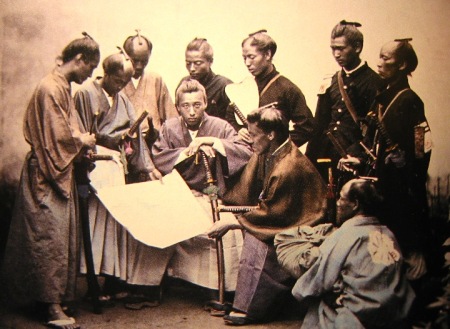The Bushido Code: The Eight Virtues of the SamuraiGo to the site to read the rest, including the Eight Virtues, which I will list below. The full explication, however, is very useful.Editor’s Note: This is a guest post from Tim Clark. He blogs at Soul Shelter with novelist Mark Cunningham. Make sure to check out Tim Clark’s second book, The Swordless Samurai.
“So, boy. You wish to serve me?”
Silhouetted against the blue-black sky, the horse-mounted samurai with the horned helmet towered over me like a demon as I knelt in the dirt before him. I could not see his face but there was no mistaking the authority in his growling tone, nor the hint of mockery in his question.
I tried to speak and managed only a faint croak. My mouth had gone dry, as parched as a man dying of thirst. But I had to respond. My fate-and though I didn’t know it then, the fate of all of Japan-rested on my answer.
Raising my head just enough to brave a glance at the demonic figure, I saw him staring at me, like a hawk poised to seize a mouse in its talons.
When I managed to speak, my voice was clear and steady, and I drew courage with each syllable.
“That’s correct, Lord Nobunaga,” I said. “I do.”
It was a time of carnage and darkness: the Age of Wars, when the land was torn by bloodshed and the only law was the law of the sword. A peasant wandered the countryside alone, seeking his fortune, without a coin in his pocket. He longed to become the epitome of refined manhood-a samurai-but nothing in the demeanor of this five-foot tall, one-hundred-ten-pound boy could possibly have foretold the astounding destiny awaiting him.
His name was Hideyoshi, and on that fateful spring evening in the year 1553, the brash young warlord Nobunaga hired him as a sandal-bearer. Driven by a relentless desire to transcend his peasant roots, Hideyoshi went on to become Nobunaga’s loyal protégé and right-hand man. Ultimately he became the supreme ruler of all Japan-the first peasant ever to rise to the absolute height of power-and unified a nation torn apart by more than a hundred years of civil strife.
Hideyoshi’s true story has inspired countless novels, plays, movies-even video games-for more than four centuries. Born the weakling son of a poor farmer at a time when martial prowess or entry to the priesthood were the only ways for an ambitious commoner to escape a life of backbreaking farm toil, he rose from poverty to rule a mighty nation and command hundreds of thousands of samurai warriors. For generations of men, Hideyoshi became the ultimate underdog hero: a symbol of the possibility of reinventing oneself as a man and rising, Horatio Alger fashion, from rags to riches.
Hideyoshi was driven by a burning desire to succeed as a samurai. But he differed from his contemporaries in seeking to overcome his adversaries peaceably, through negotiation and alliance building rather than through brute force. Lacking physical strength and fighting skills, he naturally chose to rely on wits rather than weapons, on strategy over swords. An unlikely samurai, indeed. Or was he?
A Brief History of the Samurai
The word samurai originally meant “one who serves,” and referred to men of noble birth assigned to guard members of the Imperial Court. This service ethic spawned the roots of samurai nobility, both social and spiritual.
Over time, the nobility had trouble maintaining centralized control of the nation, and began “outsourcing” military, administrative, and tax collecting duties to former rivals who acted like regional governors. As the Imperial Court grew weaker, local governors grew more powerful. Eventually some evolved into daimyo, or feudal lords who ruled specific territories independently of the central government. In 1185 Minamoto no Yoritomo, a warlord of the eastern provinces who traced his lineage back to the imperial family, established the nation’s first military government and Japan entered its feudal period (1185-1867). The country was essentially under military rule for nearly 700 years.
But the initial stability Minamoto achieved failed to bring lasting peace. Other regimes came and went, and in 1467 the national military government collapsed, plunging Japan into turmoil. Thus began the infamous Age of Wars, a bloody century of strife when local warlords fought to protect their domains and schemed to conquer rivals.
By the time Japan plunged into the turbulent Age of Wars, the term samurai had come to signify armed government officials, peacekeeping officers, and professional soldiers: in short, almost anyone who carried a sword and was ready and able to exercise deadly force.
The worst of these medieval Japanese warriors were little better than street thugs; the best were fiercely loyal to their masters and true to the unwritten code of chivalrous behavior known today as Bushido (usually translated as “Precepts of Knighthood” or “Way of the Warrior”). Virtuous or villainous, the samurai emerged as the colorful central figures of Japanese history: a romantic archetype akin to Europe’s medieval knights or the American cowboy of the Wild West.
But the samurai changed dramatically after Hideyoshi pacified Japan. With civil society at peace, their role as professional fighters disappeared, and they became less preoccupied with martial training and more concerned with spiritual development, teaching, and the arts. By 1867, when the public wearing of swords was outlawed and the warrior class was abolished, they had evolved into what Hideyoshi had envisioned nearly three centuries earlier: swordless samurai.
I. Rectitude or Justice
II. Courage
III. Benevolence or Mercy
IV. Politeness
V. Honesty and Sincerity
VI. Honor
VII. Loyalty
VIII. Character and Self-Control

1 comment:
you should read some of my books on this subject...if you can find them ;)
-me
Post a Comment